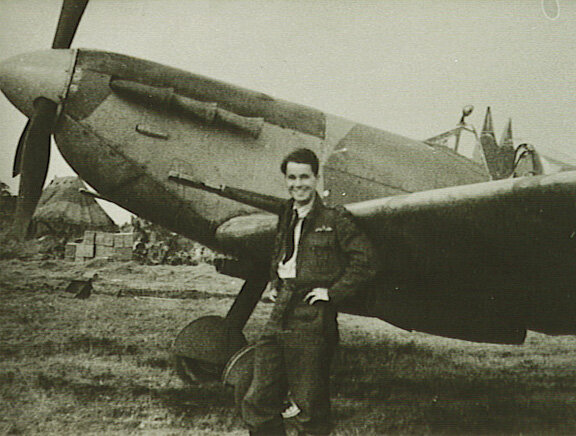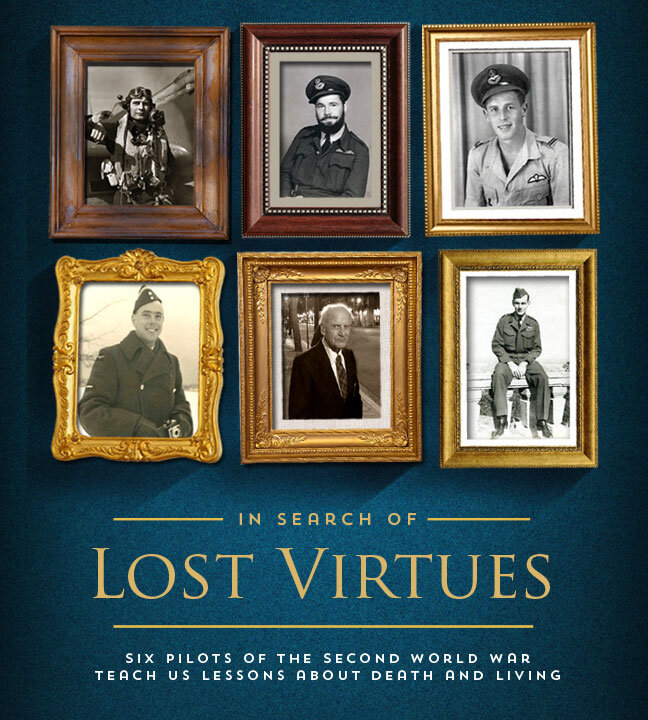HOME FOR CHRISTMAS AT BIGGIN HILL
Of my five Christmas celebrations in wartime RCAF units, 1943 was the most memorable. The earlier years had not been without their unusual features. The first, 1940, when I was at Portage la Prairie EFTS, we were given 36 hour passes on December 24th, plus a rail pass to our home town. My home was a 12 hour train ride, each way, leaving me with 12 hours at home. The following year, 1941, I was with 132 RAF squadron at Peterhead, Scotland, but at Christmas we were on a one flight detachment to Montrose, relieving a Czech squadron. Christmas of 1942 was a real change - two degrees north of the equator at Takoradi in what is now Ghana. Those of us who were not down with malaria observed a rather subdued Christmas. I recall joining with our Sergeant pilots at their quarters, tearing into some roasted chickens we had bought in town. My final Christmas, 1944, was a quite civilized affair at the Rockcliffe mess, but the year of excitement was Christmas 1943 at Biggin Hill.
On the morning of December 24th, 1943, we had been briefed for a Wing operation with zero hour 12:30. It was unusual in that we (401 Squadron) were to team up with an RAF squadron, No. 501 from RAF Hawkinge, to escort 72 Marauders bombing a `Noball’ site [A V-1 Launch site- Ed] near Le Touquet. The other two squadrons of the Wing, 411 and 412, would be escorting a similar force to another Noball site. I normally flew in `A’ flight but on this operation was flying Red 4 in the section led by newly appointed S/L Lorne “Boss” Cameron, (although the OR still listed him as F/L). It was a very easy trip, a milk run which took only an hour, but in that short time the entire southern half of Britain, at least within our range, had completely fogged in except for Manston, where we were ordered to land. Manston was the closest airfield to the coast of France, and in 1943 had been upgraded to serve as an emergency field; the main runway was 3,000 yards by 250 yards, three times the length and five times the width of our usual strips. In addition there was a 2,000 yard loop for dispersing. All of it was needed this day. Our wing had no sooner got down and out of the way when half the force from the day’s operations began to arrive, Marauders, Mitchells, Thunderbolts, Mustangs, and I recall seeing at least one Liberator. Despite the available room there were a number of ground collisions, but not with our machines. We all went up to the Officers mess, including our NCO’s, who were told to keep on their electrically heated coveralls which had no rank insignia. We hung around watching the crowd grow with each new arrival until it got to the point where it was almost impossible to move. With no money in our pockets we couldn’t even buy a drink.
Bill McRae and a 401 Squadron Spitfire V at RAF Redhill. Photo via Bill McRae
It is not clear who was leading the Wing that day, if anyone; Buck McNair was our Wing Commander but he had been on leave all week and there is nothing in the record to indicate his return before Christmas. S/L Ormiston of 411 was out of action due to serious injuries following an engine failure on takeoff a couple of days earlier, while he was leading the Wing. It may have been S/L Cameron of 401 who said: “To hell with this, we’re not spending Christmas Eve here, we’re going back to Biggin”, and we all trooped back to the field again. When our 36 Spitfires arrived over Biggin Hill it was, as we had been told, completely socked in so we carried on another five miles to RAF Kenley. It too was shrouded in fog, but they began firing orange smoke markers up through the stuff. With the three of us following in tight formation Cameron spiralled down around the smoke trail. When we broke out we were right over the centre of the field at about 200 feet. Cameron immediately dropped his wheels and flaps and began a tight turn in to the first runway he saw. Kenley had two runways, one of 1,000 yards heading SW-NE, the other 1,200 yards heading SE-NW. They crossed each other close to the southern ends so that, approaching from the south, each runway had about 200 yards to the intersection. It was from this end we were approaching. Normally when we broke off for landing we would fan out so that each aircraft made a wider curving approach. The two fellows ahead of me did not do this; with visibility less than a mile I suppose they thought sight of the field could be lost in a wide approach so they stayed right behind Cameron, trying to give themselves space by slowing down to a minimum. I had the speed down to about 130 mph, nose high, to open a gap from No. 3. When I finally curved in to the runway I had slowed down to 90 and could see Cameron almost at the end, No. 2 about halfway and No. 3 just crossing the intersection about 200 yards ahead of me. As I reached the end of the runway I closed the throttle and dropped like a stone; it was the shortest landing I ever made in a Spitfire.
Squadron Leader Lorne “Boss” Cameron cuts a dashing figure standing next to his Spitfire. Photo via Bill McRae
Yellow and Blue sections then followed in turn. With all twelve of our aircraft down, 412 Squadron was next and they too all got down safely. Then it was 411’s turn. Red section of four aircraft landed successfully on the same runway we had used. Yellow 1 was next, followed by Yellow 2, but just as Yellow 3 was about to touch down Yellow 4 crossed in front of him landing on the intersecting runway! Fortunately Yellow 3 was able to abort the landing. Now, the Station Commander here was Iron Bill McBrien, who, we were later told, had been planning a party for the local kids. Dressed as Santa Claus, he intended to fly the Tiger Moth around within the confines of the field before landing in front of the kids. Whether this was true or not I can’t say. Perhaps it was because the unexpected and unorthodox arrival of 36 Spitfires had spoiled his party, or perhaps he was concerned for safety and did not appreciate the near collision, but in any event he now ordered that no more aircraft were to land and the five still in the air were diverted to RAF Dunsfold. Transport was arranged for us and the Dunsfold five, getting us all back to Biggin for a late start on the partying. Our squadron had had a rough week; our well-liked S/L, tour expired, was grounded; three pilots had been lost over France and two others were grounded pending posting out, punishment for taxiing accidents. One of these, a popular American in the RCAF, would commit suicide a few days later. The boys were ready to let their hair down and for some the party went on most of the night.
Christmas Day or not, an operation was laid on for 11:00. Most of our serviceable aircraft were still at Kenley, so we were up at dawn to be trucked there to pick them up and fly them back to Biggin by 9:00. We landed just as the fog rolled in over Biggin again; mercifully the operation was cancelled and the Wing stood down for the rest of the day. After taking advantage of an invitation for drinks at the Sergeants Mess we performed the traditional role of serving the enlisted men their Christmas meal. Then we were treated to the luxury of an excellent buffet lunch in the pre-war RAF mess. I can recall all that part, but not the wild shenanigans that the Squadron diary records thereafter. My name is not mentioned, so I’m not sure if I skipped out or if I was in as bad a state as most of the others seem to have been, which could account for my loss of memory. The following day, our prayers were answered - the weather was once again a washout and a scheduled operation was cancelled. Had it not been, there would have been sufficient serviceable aircraft but few serviceable pilots.
Flight Lieutenant William “Bill” McRae, Vintage Wings of Canada
This is Vintage Wings of Canada's first Christmas without Bill McRae. Bill died this year shortly after last Christmas, but not before we had the chance to tell him how much we loved him.









